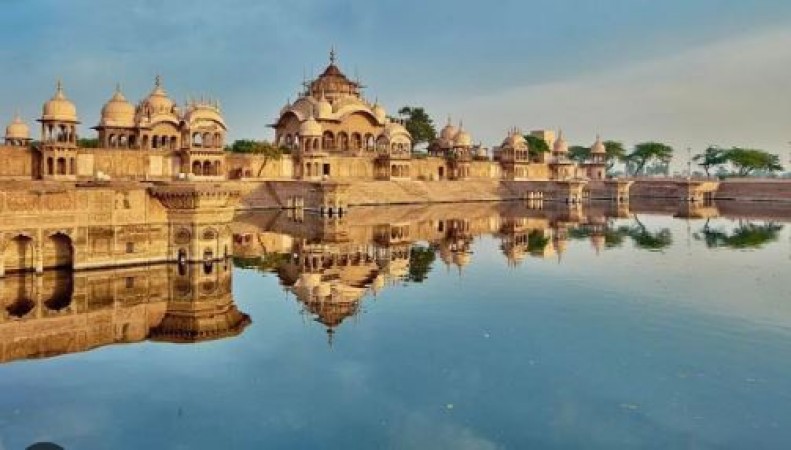
Mathura derived its importance as a center of trade due to its location where the northern trade route of the Indo-Gangetic Plain met with the routes to Malwa and the west coast. By the 6th century BCE Mathura became the capital of the Surasena Kingdom.
Mathura is a sacred city in Uttar Pradesh, northern India. The deity Lord Krishna is said to have been born on the site of Sri Krishna Janma Bhoomi. There are 25 ghats of which Vishram Ghat is considered the holiest. Sati Burj is a 16th-century memorial tower. Dwarkadhish Temple has a carved entrance and a black-marble idol of Lord Krishna. One side of Mathura is stretched across the Yamuna River, lined with 25 ghats, which are best visited during dawn when you can witness locals and tourists taking a holy dip, and at dawn (just after the sunset) when hundreds of diyas are floated during the daily aarti. Mathura is flooded with tourists and pilgrims during the two main festivals (JANMASHTAMI) Lord Krishna's birthday in August/September, and Holi in February/March. Shri Krishna Janmabhumi is the most famous tourist attraction in Mathura, as this place is believed to be the exact place where Lord Krishna was born, and the prison where he was born is now on display for tourists to see. Mathura has many big and small temples dotting the entire city, with many of these temples dedicated to Lord Krishna. The two most important temples in town are the Dwarkadeesh Temple and the Gita Mandir. The best way to explore Mathura is by taking a walk around the streets of the city. Every nook and cranny of this religious town still retains an old-world charm that belies the urbanization the city has kept up with.
There is a lot of history to Mathura that you can experience only by exploring the old-fashioned architecture, the crumbling ruins of old houses, and the genial amiability of the locals who are always willing to show you around. It is not possible to think of a city as old as Mathura and imagine it not having a delicious history of street food! Don’t forget to try out local snacks like kachoris, aloo-puri, and chaat, which are available at any eateries lining the streets. Jalebis and gulab-jamuns are also very popular local street food items that are available at all shops throughout the day. Mathura is one of India's famous holy cities, which is also known for its street food.
It is famous for sweets, especially “Peda”, a sweet dish made from khoa, sugar, and traditional flavorings. Traditionally it is believed that it was founded by Shatrughna after killing Yadava Lavana at the site of Madhuvana. According to Ramayana, it was founded by Madhu, A man of the Yadu tribe. The female figures at Mathura, carved in high relief on the pillars and gateways of both Buddhist and Jaina monuments, are frankly sensuous in their appeal.
There is hardly any need to mention that the city of Mathura (and the whole of Brajbhumi, for that matter) is not an ordinary material city, for it is the transcendental abode of Lord Krishna and His consorts and a Cosmic Place for His Divine ‘Leela’ sport. Mathura has an ancient history and finds a place in the oldest Indian epic - the Ramayana. The Ramayana says that Shatrughna, the Ikshwaku prince, had slayed a Demon called Lavanasura and gained the place. Later on, the place came to be known as Madhuvan, being wooded thickly, still later Madhupura, and finally Mathura. By the fifth century BC, in the times of Buddha, it acquired the status of a major metropolis and the capital of the Surasena kingdom - one of the sixteen ‘Mahajanapadas’ of that era. Mathura went on to see its golden era during the rule of the Kushanas when ably governed by rulers of the like of Vashishka, Huvishka, and Kanishka, its art and culture flourished and its economic wealth was minted.
On his journey to India in the 3rd century BC, the famous historian Megasthenes describes Mathura not only as a place of great regional importance but goes on to suggest that it was then, as it is even today, a center of Krishna worship. About A.D. 400, the Chinese traveler, Fa Hien, mentions the city, as it were, as a center of Buddhism and many famous temples; the city was ransacked and quite a few of its temples were destroyed and defiled by Mahmud Ghazni and, later on, by Sikandar Lodhi.
Mathura forms the nucleus of Braj Bhumi, the land known for the childhood pranks and youthful sports of Lord Shri Krishna. Encompassing an area of approximately 3,800 sq. km., Brajabhumi can be broadly divided into two distinct units - the eastern side of the Yamuna with places like Gokul, and the western part in the trans-Yamuna tract that covers the Mathura area covering Vrindavan, Govardhan, Barsana and Nandgaon / Nandagram. Mathura enjoys a climate that is typically north Indian. During summer, the mercury may jump even up to 45 degree Celsius while it hardly goes below 27 degrees Celsius on the lower side. Thus, the scorching heat and almost unbearable humidity of the summer months turn many a tourist away from visiting the holy town from April to June. However, during monsoon, Mathura gets a benign level of rainfall of 20 mm on average from June to August, which brings the mercury down sharply.
Winters, the months from December to February, on the other hand, remain comfortable and pleasant, though you may feel a little chilly occasionally. During this period, the minimum temperature more than often drops below 4-5 degrees Celsius while the maximum mostly stands at about 12-14 degrees Celsius.
ALSO READ B CCI's Salary Shake-Up: Agarkar's Appointment Promises Better Compensation DealCelebrating the 88th Birthday of the Dalai Lama - A Life of Wisdom and CompassionPM Modi pays tribute to Syama Prasad Mookerjee on his birth anniversary popular popular popularPopular Places To Visit In Arunachal Pradesh